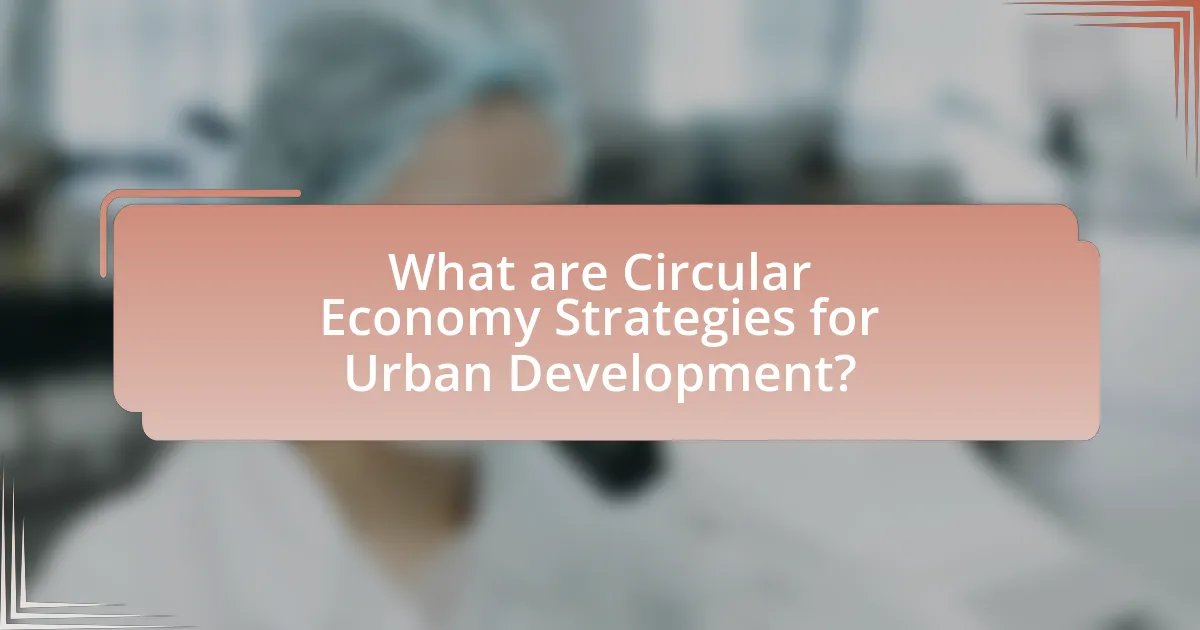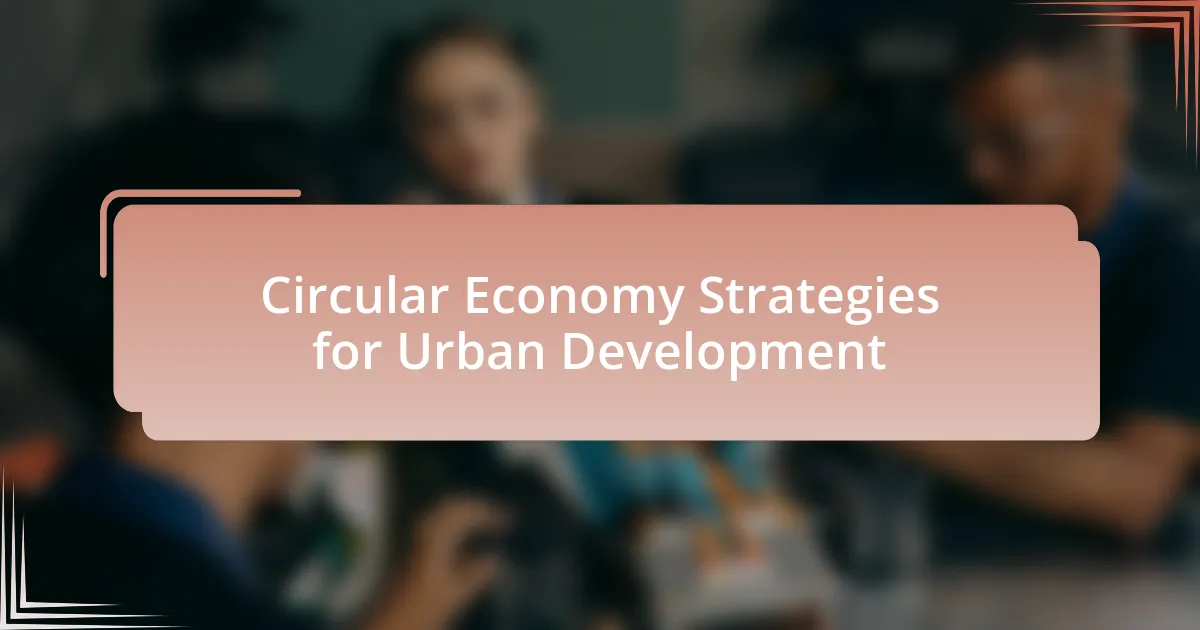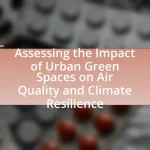Circular economy strategies for urban development aim to minimize waste and maximize resource efficiency in urban environments. These strategies encompass practices such as recycling, sustainable transportation, and long-lasting building designs, with cities like Amsterdam serving as notable examples of successful implementation. The article explores the differences between circular economy approaches and traditional urban development, the principles that underpin these strategies, and the key components necessary for effective execution. It also addresses the challenges cities face, the role of technology and stakeholder engagement, and highlights successful case studies while discussing future trends and practical steps for urban planners.

What are Circular Economy Strategies for Urban Development?
Circular economy strategies for urban development focus on minimizing waste and maximizing resource efficiency within urban environments. These strategies include promoting recycling and reuse of materials, implementing sustainable transportation systems, and designing buildings for longevity and adaptability. For instance, cities like Amsterdam have adopted circular economy principles by integrating waste management into urban planning, which has led to a significant reduction in landfill use and increased recycling rates. Additionally, the Ellen MacArthur Foundation reports that transitioning to a circular economy could generate economic benefits of up to $4.5 trillion by 2030, highlighting the potential for urban areas to thrive economically while being environmentally sustainable.
How do Circular Economy Strategies differ from traditional urban development approaches?
Circular Economy Strategies prioritize resource efficiency and waste reduction, contrasting with traditional urban development approaches that often emphasize growth and consumption. In a circular economy, materials are reused, recycled, and repurposed, aiming to create closed-loop systems that minimize environmental impact. For example, the Ellen MacArthur Foundation highlights that circular practices can reduce greenhouse gas emissions by up to 70% in urban settings. Traditional urban development typically leads to increased waste and resource depletion, as seen in cities that expand without integrating sustainable practices. Thus, the fundamental difference lies in the circular economy’s focus on sustainability and resource regeneration versus the linear model of consumption inherent in traditional urban development.
What principles underpin Circular Economy Strategies in urban contexts?
Circular Economy Strategies in urban contexts are underpinned by principles such as resource efficiency, waste minimization, and systems thinking. Resource efficiency emphasizes the optimal use of materials and energy to reduce consumption and environmental impact. Waste minimization focuses on designing products and processes that reduce waste generation, promoting recycling and reuse. Systems thinking encourages a holistic approach, considering the interconnections between various urban systems, including transportation, energy, and waste management. These principles are supported by frameworks like the Ellen MacArthur Foundation’s Circular Economy model, which highlights the importance of closing resource loops and creating sustainable urban ecosystems.
How do these strategies promote sustainability in urban areas?
Circular economy strategies promote sustainability in urban areas by minimizing waste and maximizing resource efficiency. These strategies encourage the reuse, recycling, and repurposing of materials, which reduces the demand for new resources and lowers environmental impact. For instance, cities implementing circular economy practices can divert up to 70% of waste from landfills, as seen in cities like Amsterdam, which has adopted policies to support circular initiatives. This not only conserves natural resources but also fosters economic growth through new business models focused on sustainability, ultimately leading to a more resilient urban environment.
What are the key components of Circular Economy Strategies in urban development?
The key components of Circular Economy Strategies in urban development include waste reduction, resource efficiency, and sustainable design. Waste reduction focuses on minimizing the amount of waste generated through practices such as recycling and composting, which can lead to a decrease in landfill use. Resource efficiency emphasizes the optimal use of materials and energy, promoting practices like energy recovery and the use of renewable resources. Sustainable design integrates these principles into urban planning, ensuring that buildings and infrastructure are designed for longevity, adaptability, and minimal environmental impact. These components collectively contribute to a more sustainable urban environment, as evidenced by cities like Amsterdam, which has implemented circular economy principles to reduce waste by 50% by 2030.
What role do waste management practices play in these strategies?
Waste management practices are essential in circular economy strategies for urban development as they facilitate resource recovery and minimize environmental impact. Effective waste management enables the recycling and repurposing of materials, which reduces the need for virgin resources and lowers greenhouse gas emissions. For instance, cities that implement comprehensive recycling programs can divert up to 60% of waste from landfills, significantly contributing to sustainability goals. Additionally, proper waste management practices support the creation of a closed-loop system where waste is treated as a resource, thereby enhancing economic efficiency and promoting sustainable urban growth.
How does resource recovery contribute to urban sustainability?
Resource recovery significantly contributes to urban sustainability by minimizing waste and promoting the reuse of materials. This process reduces the demand for new resources, thereby lowering environmental impact and conserving natural ecosystems. For instance, cities that implement effective resource recovery systems can divert up to 90% of waste from landfills, as demonstrated by San Francisco’s zero waste initiative. Additionally, resource recovery can generate economic benefits, such as job creation in recycling and processing industries, which supports local economies and fosters community resilience.
What challenges do cities face when implementing Circular Economy Strategies?
Cities face several challenges when implementing Circular Economy Strategies, including lack of funding, insufficient infrastructure, and resistance to change from stakeholders. Funding is often limited, making it difficult for cities to invest in necessary technologies and systems that support circular practices. Additionally, existing waste management and recycling infrastructure may not be equipped to handle the complexities of a circular economy, leading to inefficiencies. Resistance from businesses and residents can also hinder progress, as stakeholders may be reluctant to adopt new practices or change established behaviors. These challenges are documented in various studies, such as the Ellen MacArthur Foundation’s report on circular economy implementation, which highlights the financial and logistical barriers cities encounter.
How can financial constraints impact the adoption of these strategies?
Financial constraints can significantly hinder the adoption of circular economy strategies for urban development by limiting the available resources for investment and implementation. When municipalities or organizations face budget restrictions, they may prioritize immediate needs over long-term sustainability initiatives, resulting in a lack of funding for innovative projects that promote resource efficiency and waste reduction. For instance, a study by the Ellen MacArthur Foundation highlights that cities with limited financial resources often struggle to invest in necessary infrastructure, such as recycling facilities or renewable energy systems, which are essential for effective circular economy practices. Consequently, financial limitations can lead to slower progress in transitioning towards sustainable urban environments.
What social barriers exist in transitioning to a circular economy in urban settings?
Social barriers in transitioning to a circular economy in urban settings include lack of public awareness, resistance to change, and socioeconomic disparities. Lack of public awareness hinders community engagement and participation, as many individuals do not understand the benefits or principles of a circular economy. Resistance to change is often rooted in established habits and skepticism towards new practices, making it difficult to adopt innovative recycling and resource management strategies. Socioeconomic disparities further complicate the transition, as marginalized communities may lack access to resources, education, and infrastructure necessary for effective participation in circular initiatives. These barriers collectively impede the successful implementation of circular economy strategies in urban environments.

How can cities effectively implement Circular Economy Strategies?
Cities can effectively implement Circular Economy Strategies by integrating waste management, resource recovery, and sustainable design into urban planning. This approach involves establishing systems for recycling and reusing materials, which can significantly reduce waste; for instance, cities like Amsterdam have achieved a recycling rate of over 60% through comprehensive waste separation and collection programs. Additionally, cities can promote local businesses that utilize circular practices, such as repair shops and second-hand markets, fostering a culture of sustainability. Evidence from the Ellen MacArthur Foundation indicates that transitioning to a circular economy could generate $4.5 trillion in economic benefits globally by 2030, highlighting the potential for cities to enhance both environmental and economic outcomes through these strategies.
What best practices should cities follow for successful implementation?
Cities should prioritize stakeholder engagement for successful implementation of circular economy strategies. Engaging local communities, businesses, and government entities fosters collaboration and ensures that diverse perspectives are considered, leading to more effective solutions. Research indicates that cities with strong stakeholder involvement, such as Amsterdam, have seen increased public support and participation in circular initiatives, resulting in higher success rates. Additionally, cities should establish clear metrics for measuring progress, as evidenced by the European Commission’s Circular Economy Action Plan, which emphasizes the importance of data-driven decision-making to track the effectiveness of implemented strategies.
How can stakeholder engagement enhance the effectiveness of these strategies?
Stakeholder engagement enhances the effectiveness of circular economy strategies for urban development by fostering collaboration and ensuring diverse perspectives are integrated into decision-making processes. Engaging stakeholders, such as local communities, businesses, and government entities, leads to more comprehensive and contextually relevant strategies that address specific local needs and challenges. For instance, a study by the Ellen MacArthur Foundation highlights that involving stakeholders in the design phase of urban projects can increase acceptance and support, ultimately leading to higher success rates in implementation. This collaborative approach not only improves resource efficiency but also promotes innovation and sustainability, as stakeholders contribute unique insights and expertise that can refine and optimize circular economy initiatives.
What role does technology play in facilitating Circular Economy practices?
Technology plays a crucial role in facilitating Circular Economy practices by enabling efficient resource management and waste reduction. Advanced technologies such as the Internet of Things (IoT), artificial intelligence (AI), and blockchain enhance tracking, monitoring, and optimizing resource flows. For instance, IoT devices can provide real-time data on resource usage, allowing businesses to minimize waste and improve recycling processes. According to a report by the Ellen MacArthur Foundation, implementing digital technologies can lead to a 30% reduction in resource consumption in urban settings. This demonstrates that technology not only supports the principles of the Circular Economy but also drives significant environmental and economic benefits.
What examples of successful Circular Economy Strategies exist in urban development?
Successful Circular Economy Strategies in urban development include the implementation of waste-to-energy systems, urban farming initiatives, and the promotion of shared mobility services. For instance, cities like Amsterdam have adopted a circular approach by integrating waste management with energy production, converting organic waste into biogas for energy use. Additionally, urban farming projects in cities such as Detroit have transformed vacant lots into productive agricultural spaces, enhancing local food security while reducing transportation emissions. Furthermore, shared mobility services in cities like San Francisco have reduced the number of vehicles on the road, promoting efficient use of resources and decreasing urban congestion. These strategies demonstrate effective resource management and sustainability in urban environments.
Which cities have effectively integrated these strategies into their urban planning?
Cities that have effectively integrated circular economy strategies into their urban planning include Amsterdam, Copenhagen, and San Francisco. Amsterdam has implemented a circular economy program that focuses on reducing waste and promoting resource efficiency, exemplified by its “Amsterdam Circular” initiative, which aims to transition to a fully circular economy by 2050. Copenhagen has adopted a comprehensive waste management strategy that emphasizes recycling and resource recovery, with a goal to become carbon neutral by 2025. San Francisco has established one of the most ambitious zero waste goals in the United States, achieving a diversion rate of over 80% through extensive recycling and composting programs. These cities serve as leading examples of how urban planning can incorporate circular economy principles to enhance sustainability and resource management.
What lessons can be learned from these successful implementations?
Successful implementations of circular economy strategies in urban development demonstrate the importance of stakeholder collaboration, resource efficiency, and adaptive governance. Stakeholder collaboration fosters innovation and ensures diverse perspectives are integrated, as seen in cities like Amsterdam, where public-private partnerships have led to effective waste management solutions. Resource efficiency is crucial, as evidenced by the implementation of recycling programs in San Francisco, which achieved a diversion rate of over 80% from landfills, showcasing the potential for significant waste reduction. Adaptive governance allows cities to respond to changing conditions and stakeholder needs, exemplified by the flexible policies adopted in Copenhagen that support ongoing sustainability initiatives. These lessons highlight the necessity of collaboration, efficiency, and adaptability in achieving successful circular economy outcomes in urban settings.

What future trends are emerging in Circular Economy Strategies for Urban Development?
Future trends in Circular Economy Strategies for Urban Development include increased integration of digital technologies, enhanced community engagement, and a focus on regenerative practices. Digital technologies, such as IoT and blockchain, facilitate resource tracking and waste management, improving efficiency in urban systems. Enhanced community engagement ensures that local populations are involved in decision-making processes, leading to more tailored and effective solutions. Additionally, regenerative practices aim to restore ecosystems and promote biodiversity, moving beyond sustainability to actively improve environmental conditions. These trends are supported by research indicating that cities adopting circular economy principles can reduce waste by up to 50% and lower carbon emissions significantly, demonstrating the effectiveness of these strategies in urban settings.
How are innovations shaping the future of urban circular economies?
Innovations are significantly shaping the future of urban circular economies by enabling resource efficiency, waste reduction, and sustainable practices. Technologies such as smart waste management systems and digital platforms for sharing resources facilitate the efficient use of materials and energy in urban settings. For instance, cities implementing IoT-based waste collection systems have reported up to 30% reductions in operational costs and improved recycling rates, as seen in San Francisco’s waste management initiatives. Additionally, advancements in materials science, such as biodegradable plastics and upcycled materials, are transforming product design and manufacturing processes, promoting a shift towards sustainable consumption patterns. These innovations collectively enhance urban resilience and contribute to the overall sustainability goals of cities.
What role do policy changes play in advancing these strategies?
Policy changes are crucial in advancing circular economy strategies for urban development by creating a regulatory framework that incentivizes sustainable practices. These changes can include implementing waste reduction targets, promoting recycling initiatives, and providing financial support for green technologies. For instance, the European Union’s Circular Economy Action Plan, adopted in 2020, aims to make sustainable products the norm in the EU, demonstrating how policy can drive systemic change in urban environments. Such policies not only encourage businesses to adopt circular practices but also facilitate collaboration among stakeholders, ensuring that urban development aligns with sustainability goals.
How can public-private partnerships enhance Circular Economy initiatives?
Public-private partnerships can enhance Circular Economy initiatives by leveraging resources, expertise, and innovation from both sectors to create sustainable systems. These collaborations enable the sharing of risks and investments, facilitating the development of infrastructure and technologies that support recycling, waste reduction, and resource efficiency. For instance, a study by the Ellen MacArthur Foundation highlights successful partnerships that have led to the establishment of circular supply chains, demonstrating that joint efforts can significantly increase material recovery rates and reduce environmental impacts.
What practical steps can urban planners take to adopt Circular Economy Strategies?
Urban planners can adopt Circular Economy Strategies by implementing waste reduction initiatives, promoting resource efficiency, and encouraging sustainable design practices. These steps include conducting comprehensive waste audits to identify reduction opportunities, integrating recycling and composting programs into urban infrastructure, and designing buildings and public spaces that prioritize the use of renewable materials. For instance, cities like Amsterdam have successfully integrated circular principles by establishing policies that require new developments to utilize recycled materials, demonstrating a measurable decrease in waste generation. Additionally, urban planners can collaborate with local businesses to create closed-loop systems, where waste from one process becomes a resource for another, further enhancing sustainability and economic resilience.
How can cities measure the success of their Circular Economy initiatives?
Cities can measure the success of their Circular Economy initiatives through key performance indicators (KPIs) such as waste reduction rates, recycling rates, and resource recovery rates. For instance, a city may track the percentage of waste diverted from landfills to assess the effectiveness of recycling programs. Additionally, cities can evaluate economic impacts by measuring job creation in green sectors and the financial savings from reduced resource consumption. Research by the Ellen MacArthur Foundation indicates that implementing circular economy practices can lead to a 70% reduction in resource use, demonstrating the potential for significant environmental and economic benefits.
What resources are available for cities looking to implement these strategies?
Cities looking to implement circular economy strategies can access various resources, including government grants, technical assistance programs, and partnerships with academic institutions. For instance, the U.S. Environmental Protection Agency offers funding opportunities through its Sustainable Communities program, which supports local initiatives aimed at promoting sustainability and circular practices. Additionally, organizations like the Ellen MacArthur Foundation provide toolkits and case studies that guide cities in adopting circular economy principles, demonstrating successful implementations in various urban settings. These resources collectively empower cities to effectively transition towards sustainable urban development.


